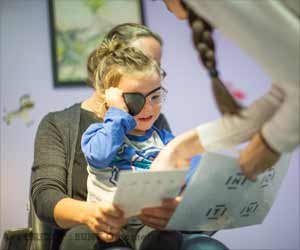Amblyopia or Poor Vision in Kids

The research team identified 17 individual studies on digital vision training for amblyopia but no conclusive results could be drawn on the effectiveness of this treatment.
Non-digital vision training involves regular vision exercises under professional guidance over a longer period of time, to train fixation or focusing. No study results are available for non-digital training.
Digital Treatment for Lazy Eye – Not so Promising!
In the ‘ThemenCheck Medizin’ procedure offered by the German Institute for Quality and Efficiency in Health Care (IQWiG), interested members of the public can submit proposals for the assessment of medical procedures and technologies.
Advertisement
A request from a member of the public was the starting point of the ‘ThemenCheck’ report. Sharp and spatial vision develops in children up to the age of 9. However, many children and adolescents are affected by developmental vision disorders such as amblyopia, near-sightedness (myopia), or far-sightedness (hyperopia).
In Europe, almost four percent of the population suffers from amblyopia; in Germany, about eleven percent of all children and adolescents between the ages of 0 and 17 are affected by myopia, which is corrected with visual aids. If amblyopia (e.g. caused by strabismus, i.e. squinting) is not treated properly, it can, for example, permanently affect spatial vision and therefore quality of life.
Currently, children with amblyopia are usually treated with occlusion therapy, which involves temporarily covering the better-seeing eye to improve vision in the weaker eye.
Against this background, a member of the public asked the ThemenCheck Medizin about the situations in which children and adolescents with vision problems can benefit from vision training.
The expert team commissioned by IQWiG investigated whether children and adolescents with developmental vision problems can be successfully treated with active vision training. In particular, this would be the case if active participation in such training led to a relevant improvement in visual acuity and binocular vision.
Evaluating Present and Future Therapeutic Options for Amblyopia
The 17 studies identified by the external experts all investigated digital vision training for amblyopia.
For the criterion “best-corrected visual acuity of the amblyopic eye”, the studies showed a benefit of digital vision training compared to no training, sham training, or occlusion therapy. However, the differences in visual acuity measured in these comparisons were so small that – according to the external experts – the children and adolescents affected did not experience any noticeable advantage.
In addition, the interaction of both eyes did not improve with training: neither in comparison to no training, nor to sham training, nor to occlusion therapy.
Temporarily taping off one eye for amblyopia can be stressful for children and adolescents and their families, for example, if it leads to stigmatization and subsequently to refusal of treatment. Replacing or at least shortening the period of occlusion therapy through digital training could therefore potentially reduce the burden of treatment.
There are no studies on non-digital vision training or on vision training for other developmental vision disorders such as myopia, hyperopia, or severe strabismus. It would be desirable for these vision training programs (which are usually paid for by the parents themselves) to be offered only if studies have shown that those affected actually benefit from them.
Reference :
- Amblyopia (Lazy Eye) – (https://my.clevelandclinic.org/health/diseases/10707-amblyopia-lazy-eye)
Source: Eurekalert
Source link
#Amblyopia #Poor #Vision #Kids



